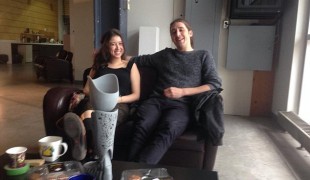- 7722
- 477
- 7
- 10
- 0
- Help Ukraine
About the solution
David grew up in Sierra Leone, during the 90s, where he saw many people - including family members and friends - lost their limbs during the civil war.
Many of these people had prosthetics, however, they didn’t wear them because they were painful. "It doesn't matter if somebody gives you a pair of shoes that are worth $200 dollars - if they're two sizes too small for you, you will not wear it; you will rather walk bare feet. This is the same thing - the prostheses were absolutely uncomfortable for them and it doesn't matter whether it was free or not, they would not wear it”, David observed.
So the inventor started working on this problem and traced the issue to the prosthetic socket.
"Seeing people who had lost their limbs and whose lives were just kind of cut short was very, very traumatising”, he stated.
While getting his PhD at MIT Media Lab, he came up with the solution. Since the prosthetic socket is the interface where the residual limb is fit into the prosthetic device, he focused on this detail.
The inventor noted that the process of fitting the limb to the socket takes at least three weeks in first world nations and can take up to a year in Sierra Leone. Plaster casting and moulding processes are still used to create the sockets, so David looked for a process that could take less time while producing better results. He did this by Using Magnetic Resonance Imaging he took the exact contour of a patient's residual limb. This data went to a finite element program to analyse the areas of greatest stress during normal patient use. Then the finite element data was sent to a 3D printer to build a multi-material prosthetic socket. Softer materials are used in areas of highest stress to provide comfort for the user. So essentially, David uses MRI scans of a patient's limbs onto a multilayer 3D printer to customise the socket design and make it more comfortable and personalised for the user.
"We are getting images, we are getting data that quantifies your body's impedance, stiffness, how stiff each point is, and we can use that with the surface information that we have, and modelling that we do, to create you a perfect shape and a multi-material impedance prosthetic socket”, he explained.
Adapted from: https://cnn.it/2ZJdCmr
https://bit.ly/2Lgs8OC
https://www.youtube.com/watch?v=rvkMauaHxBw
This solution shall not include mention to the use of drugs, chemicals or biologicals (including food); invasive devices; offensive, commercial or inherently dangerous content. This solution was not medically validated. Proceed with caution! If you have any doubts, please consult with a health professional.
DISCLAIMER: This story was written by someone who is not the author of the solution, therefore please be advised that, although it was written with the utmost respect for the innovation and the innovator, there can be some incorrect statements. If you find any errors please contact the patient Innovation team via info@patient-innovation.com
-
-
369
-
0
-
4231

Custom 3D printed prosthetics
WALKING: Walking
Limb Amputation
Limb Deformity
3d Printed
Prosthesis
Walking Aid (wheelchair/walker/crutches)
Restoring mobility
Replacing lost limbs
Promoting self-management
Promoting inclusivity and social integration
Enhancing Mental Health
Maintaining Balance and Mobility
Neurology
Orthopedics
Rheumatology
Canada
-
-
-
598
-
0
-
8553

Amputee creates 3D printed leg
-
-
-
363
-
0
-
3225

Teen creates device for his mother’s prosthetics
WALKING: Walking
WALKING WITH A WALKING AID: Walking with a walking aid
Limb Amputation
Prosthesis
Assistive Daily Life Device (to help ADL)
Difficulty walking or moving
Muscle weakness
Limited range of motion
Restoring mobility
Replacing lost limbs
Promoting self-management
General Surgery
Orthopedics
United States
-
 en
en